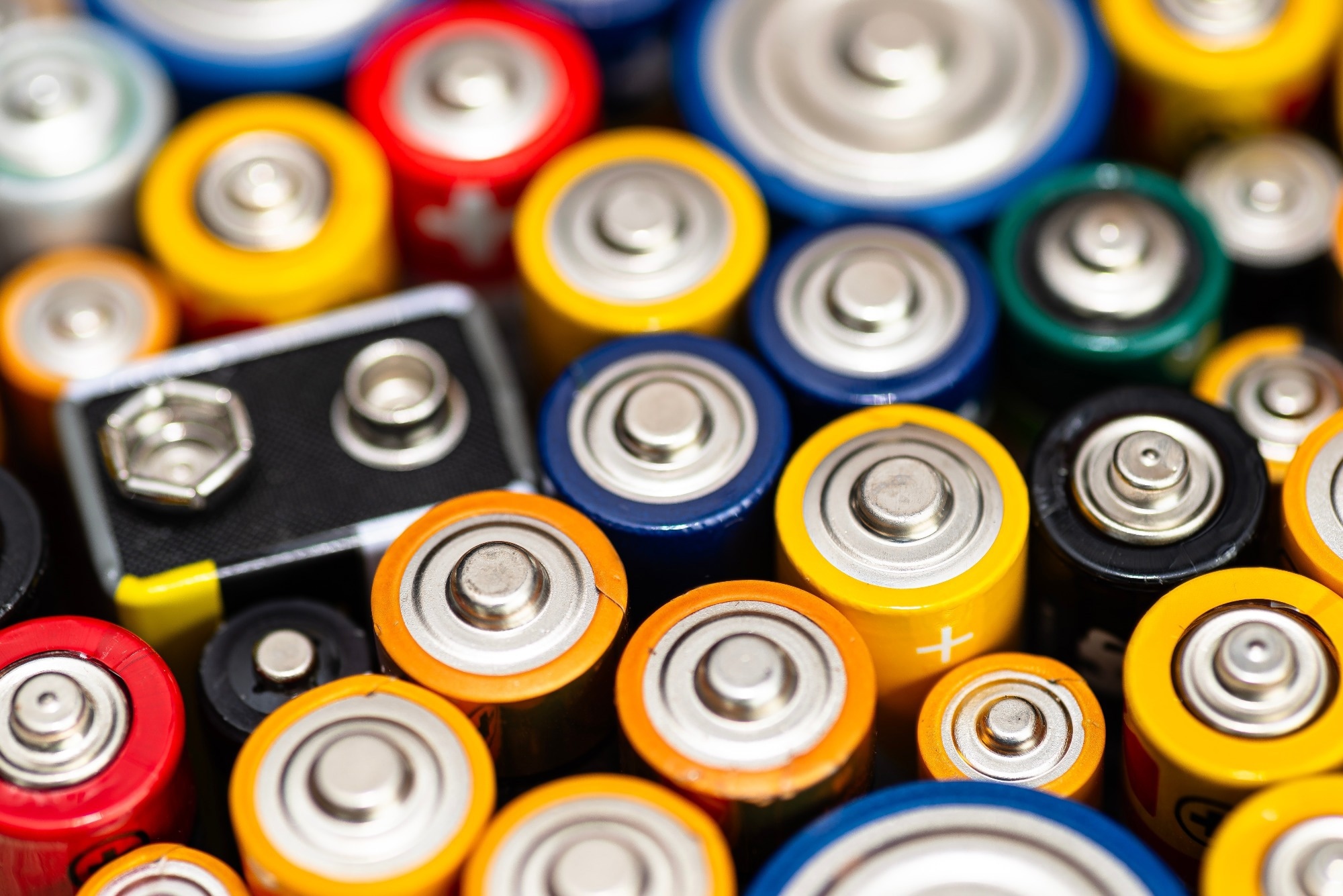 By Muhammad OsamaReviewed by Lauren HardakerJul 3 2025
By Muhammad OsamaReviewed by Lauren HardakerJul 3 2025A recent study published in Advanced Energy demonstrated that cathode microstructure significantly influences sulfur redox kinetics in lithium-sulfur batteries. Researchers utilized a spray-drying method to create sulfur-carbon composites, showing that particle morphology and size directly impact electrochemical performance under sulfur loading and lean electrolyte conditions.
These findings highlight the importance of optimizing cathode architecture for next-generation energy storage technologies to enhance battery efficiency.

Image credit: Kinek00/Shutterstock.com
The Role of Lithium-Sulfur Battery Technology
Lithium-sulfur batteries are considered a promising alternative to conventional lithium-ion (Li-ion) batteries due to their high theoretical energy density exceeding 500 Wh kg-1. This advantage arises from the high specific capacities of sulfur (1,672 mAh g-1) and lithium (3,862 mAh g-1), combined with sulfur’s abundance and low cost.
However, commercialization is limited by challenges such as poor cycle life and performance degradation under practical conditions. Key issues include lithium polysulfide (LiPS) dissolution, shuttle effects, electrode instability, and uneven sulfur utilization, all of which undermine efficiency and longevity. Therefore, optimizing the cathode microstructure is crucial for improving redox kinetics and overall battery performance.
Developing Cathode Microstructure via Controlled Composite Fabrication
Researchers optimized the cathode microstructure to address performance limitations by customizing sulfur-carbon composites at the particle level. Using spray-drying, they produced spherical ketjenblack/sulfur (SD-KB/S) particles with uniform sulfur distribution and sizes ranging from 3 to 8 µm. Subsequent thermal treatment facilitated sulfur infiltration into the carbon framework, stabilizing it in the β-phase, while preventing surface accumulation.
Compared to conventional KB/sulfur composites (C-KB/S), which suffer from sulfur agglomeration, SD-KB/S exhibited improved pore filling, reduced cracking, enhanced mechanical stability, and better cycling reliability. Comprehensive techniques such as scanning electron microscopy (SEM), X-ray diffraction (XRD), nitrogen adsorption-desorption isotherms (BET analysis), and conductive atomic force microscopy (AFM) confirmed the structural improvements. The SD-KB/S composite achieved a tap density of 0.569 g cm-3, enabling denser electrode packing and enhanced conductivity.
Notably, this spray-drying process is compatible with catalyst integration, as demonstrated with a Co9S8 catalyst for proof of concept, providing a versatile platform for future multifunctional electrode design.
Performance Enhancements via Microstructural Optimization
Electrochemical evaluations, including galvanostatic cycling, cyclic voltammetry (CV), galvanostatic intermittent titration technique (GITT), and electrochemical impedance spectroscopy (EIS), demonstrated that SD-KB/S reduced ohmic, activation, and concentration overpotentials under lean conditions, leading to improved sulfur utilization and stability. Using a cobalt sulfide (Co9S8) catalyst within the SD-KB/S matrix accelerated sulfur redox kinetics, showing excellent compatibility with catalytic enhancements.
At a sulfur loading of 4 mg cm-2 and an electrolyte-to-sulfur (E/S) ratio of 6, SD-KB/S cells retained 768 mAh g-1 after 100 cycles with a Coulombic efficiency of 97.1%. In contrast, conventional C-KB/S cells suffered rapid capacity decay and soft shorting after just 90 cycles, dropping Coulombic efficiency to ≈20%. Rate capability also improved significantly, with SD-KB/S delivering 690 and 663 mAh g-1 at C/4 and C/3, respectively, compared to less than 200 mAh g-1 for C-KB/S. Scalability was further validated in pouch cells (approximately 24 cm²), achieving 796 mAh g-1 after 40 cycles at E/S = 5 and negative-to-positive (N/P) = 6, with a low electrolyte-to-capacity (E/C) ratio of 4.6 µL mAh-1.
Structural analyses via SEM showed minimal cracking in SD-KB/S electrodes due to the spherical morphology and improved binder interactions. Additionally, BET analysis indicated more effective pore filling, while the tap density nearly doubled to 0.569 g cm-3.
Rheological studies also revealed that SD-KB/S slurries exhibited better binder-particle interactions and lower viscosity, supporting improved electrode casting quality and homogeneity.
GITT and EIS analysis demonstrated that SD-KB/S effectively reduced activation overpotential (ηact), shifting the dominant limitation toward concentration overpotential (ηcon) associated with diffusion. This transition highlights that while activation barriers are mitigated through microstructure control, new limitations emerge from ion transport and electrode tortuosity, which must be addressed for further gains.
Operando XRD confirmed uniform sulfur evolution in SD-KB/S, indicating more uniform Li2S deposition and improved reversibility compared to C-KB/S. Overall, cathode microstructure optimization improves sulfur utilization, suppresses polysulfide shuttling, enhances Coulombic efficiency, and extends cycle life, highlighting its potential in advancing lithium-sulfur battery technologies.
Moreover, as the system ages over multiple cycles, maintaining uniform Li2S growth becomes crucial in minimizing activation overpotentials and sustaining performance.
Practical Applications for Battery Materials and Design
This research has significant implications for the commercialization of lithium-sulfur batteries. It demonstrates that optimizing cathode microstructure, mainly through particle morphology and size control, plays a key role in enhancing sulfur redox kinetics and mechanical stability. Spray-drying synthesis enables the production of sulfur-carbon composites with higher density and improved electrolyte wetting, which is important for high energy density and efficient sulfur utilization.
The study emphasizes integrating catalyst development with optimized electrode architecture to maximize synergistic effects. Architectural strategies, such as lowering electrode tortuosity, are critical for reducing concentration polarization, especially once activation barriers are minimized. This approach's compatibility with catalysts allows further integration with functional binders and separator coatings to suppress polysulfide shuttling and improve redox stability.
Download your PDF copy now!
Conclusion: Toward Commercial-Scale Lithium-sulfur Systems
In summary, this study highlights the influence of cathode microstructure on sulfur redox kinetics and overall performance in lithium-sulfur batteries. Researchers achieved enhanced cycling stability, rate capability, and sulfur utilization under high-loading and lean-electrolyte conditions by employing a scalable spray-drying technique to produce spherical sulfur-carbon composites with controlled morphology and particle size. The findings suggest a holistic design approach where electrode architecture, catalyst integration, and materials chemistry are important for overcoming kinetic and transport barriers.
Future work should focus on minimizing electrode tortuosity, addressing diffusional limitations (η_con), and enhancing catalyst functionality and electrolyte transport to enable durable, high-energy-density lithium-sulfur batteries suited for commercial applications.
Overall, this research provides a foundation for the scalable production of high-performance lithium-sulfur cathodes and advances the broader goal of sustainable energy storage for electric mobility and renewable energy systems.
Journal Reference
Liao, K., & Manthiram, A. Impact of Cathode Microstructure on Sulfur Redox Kinetics in Lithium-Sulfur Batteries. Advanced Energy Materials, 2502062 (2025). DOI: 10.1002/aenm.202502062. https://advanced.onlinelibrary.wiley.com/doi/10.1002/aenm.202502062
Disclaimer: The views expressed here are those of the author expressed in their private capacity and do not necessarily represent the views of AZoM.com Limited T/A AZoNetwork the owner and operator of this website. This disclaimer forms part of the Terms and conditions of use of this website.